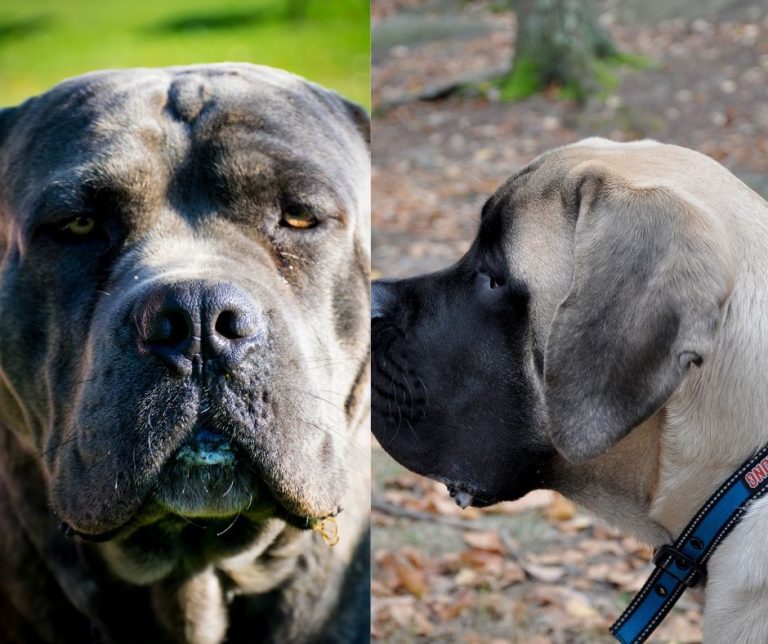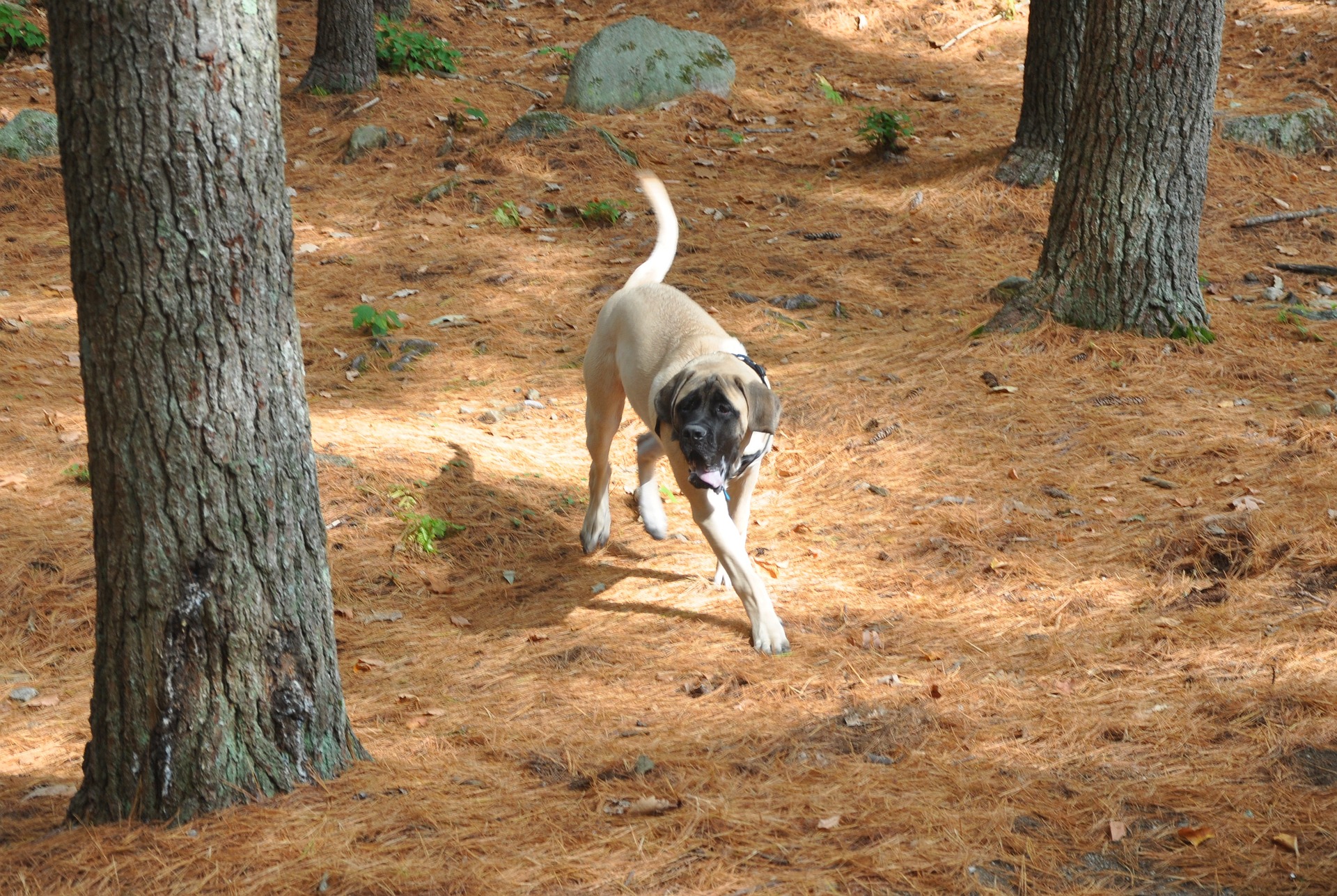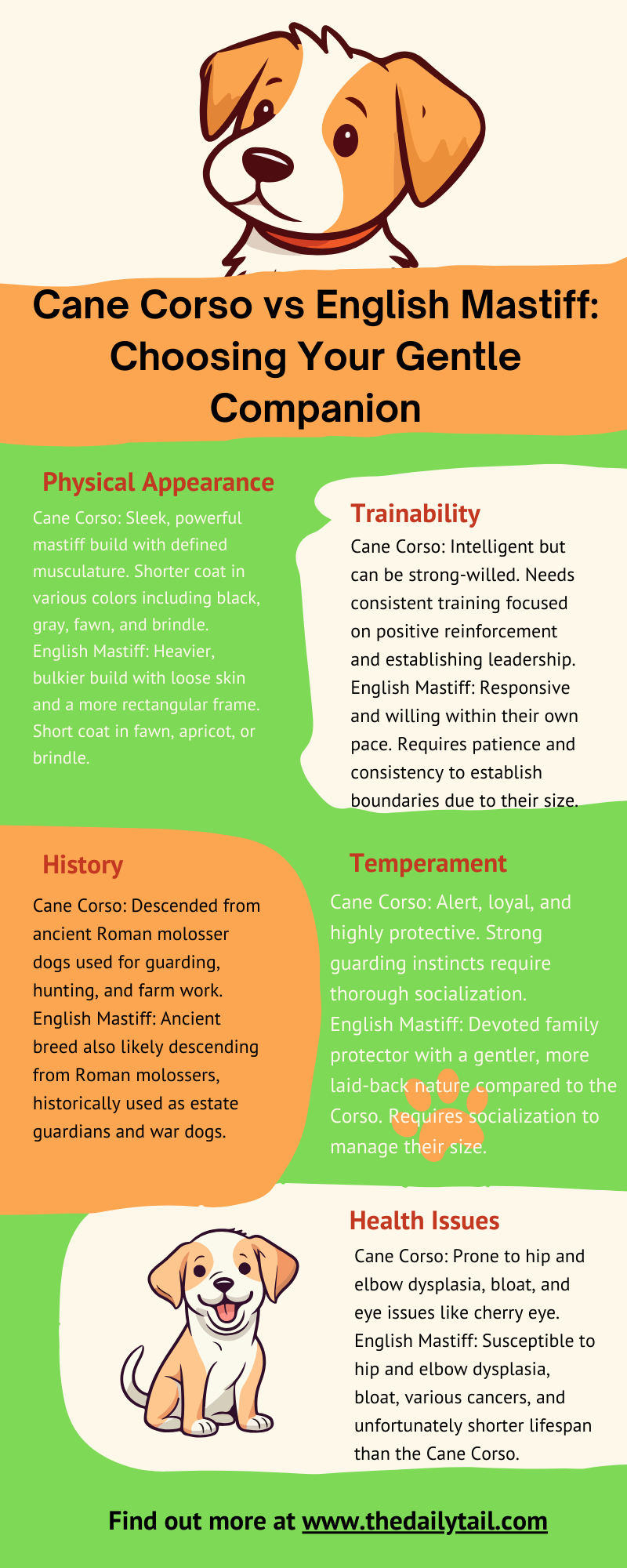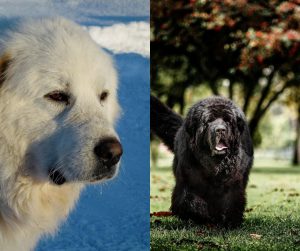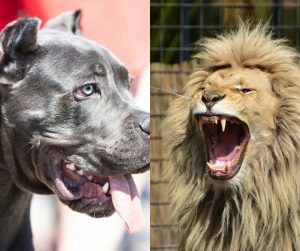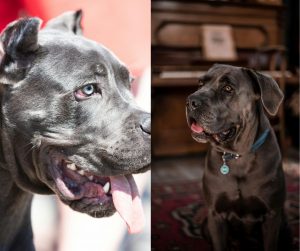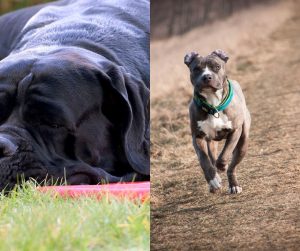Agile guardian vs. gentle giant – are you drawn to the Cane Corso’s athleticism or the English Mastiff’s mellow nature? You will be surprised, but yes, one of these two giant dogs is quite agile. I’ve seen it first hand as a dog enthusiast. Let’s break down the distinctions.
The Cane Corso and the English Mastiff stand as titans among the dog breeds, revered for their striking presence and storied pasts. Both hail from a lineage rooted in the grandeur of ancient civilizations, with roles that have evolved alongside humans through the eons. These breeds may share a family tree, but each branch bears distinct fruit—the Cane Corso, a more agile guardian hailing from Italy, and the English Mastiff, a gentle giant with an origin story on British soil.
As prospective pet owners weigh their options, understanding the nuanced contrasts between these breeds is essential.
Despite their similarities in stature, the Cane Corso and the English Mastiff paint distinctive portraits in both appearance and demeanor. The Cane Corso’s sleek, muscular frame is designed for agility and endurance, reflecting its historical role as a versatile farm dog. In contrast, the dignified English Mastiff’s impressive bulk and amiable nature made it a favored companion amongst nobility.
These physical and temperamental traits play a crucial role in their adaptation to modern family life, dictating their exercise needs, space considerations, and the nature of their bond with humans.
Their longevity, health issues, and requirements for socialization and training markedly differ—factors that hold significant weight in the decision-making process for anyone seeking a companion that fits into their lifestyle puzzle. Prospective owners should consider not just the size of their home but the size of their heart, as both the Cane Corso and English Mastiff are bound to fill it to the brim with loyalty and affection. Let’s take a look at the Cane Corso vs English Mastiff dog breed comparison.
Key Takeaways
- Cane Corsos are agile, and English Mastiffs are gentle giants, both with distinct characteristics suited for different family needs
- Physical traits and personality differences are significant to understand for a harmonious household integration
- Health, lifespan, and care requirements are essential factors in selecting either breed as a lifelong companion
Breed Origins and History
It’s fascinating to explore the rich heritage of the Cane Corso and the English Mastiff, as they both share a past intertwined with human history. Their stories take us on a journey from ancient battlefields to the brink of disappearing forever, with a legacy that has traveled through time to modern days.
Cane Corso History
The Cane Corso dog breed’s lineage goes way back to Ancient Rome, where they served alongside Roman legions, functioning as powerful war dogs. Later on, in Italy, they found their place as multipurpose farm dogs, known for their guarding skills and occasionally being used as hunting companions for large game like wild boar. The breed’s protective instincts are deeply ingrained, a trait that reflects their historical role. The Cane Corso, which roughly translates to “bodyguard dog,” nearly faced extinction before enthusiasts sought to revive the breed.
Nowadays, many people call the Cane Corso breed an Italian Mastiff or Neapolitan Mastiff due to his ancestry.
English Mastiff History
Turning to the English Mastiff, their story is equally grounded in antiquity. Records suggest that their ancestors were brought to England by Julius Caesar’s troops to face the British. Over centuries, these dogs were shaped into the English Mastiff, reputed for their enormous size and gentle nature. Their lineage could be traced back to a mix that likely included Neapolitan and perhaps even Tibetan Mastiffs. They have been used in a variety of roles, from guard dogs to war dogs, showing a resilient adaptability to survive the changing tides of history.
Physical Characteristics
When you look at the Cane Corso and the English Mastiff, you can’t help but be impressed. They’re both sizable breeds with remarkable physical traits. Let’s get a closer look at what sets these two apart.
Size and Weight
The Cane Corso is a muscular and robust dog, with males typically standing between 24-28 inches in height and weighing in at 90-110 pounds. On the other side, the English Mastiff is a gentle giant, often much larger, with heights of 27-30 inches and a weight range that can tip the scales at a staggering 120-230 pounds.
| Breed | Height (inches) | Weight (pounds) |
|---|---|---|
| Cane Corso | 23-28 | 90-110 |
| English Mastiff | 27-30 | 120-230 |
Coat and Colors
The Cane Corso’s coat is short and can come in a variety of colors such as black, gray, fawn, and red, sometimes with brindle patterns. On the other hand, the English Mastiff’s coat, also short, can display similar colors and patterns, but they might be seen more commonly in fawn or brindle shades. They both have coats that require minimal maintenance, but their striking colors contribute greatly to their majestic appearance.
Distinctive Features
Both breeds have distinctive features that make them stand out. The Cane Corso dog breed has ears that tend to be of medium size and can be cropped or natural, contributing to their alert and vigilant expression. In contrast, the Mastiff’s ears are small, set wide apart, and blend into their massive, rounded skulls. When you look at their eyes, you see a mirror of their soul—deep, thoughtful, and often described as looking like they understand every word you say.
Personality and Temperament
When choosing between a Cane Corso vs English Mastiff, it’s essential to understand their distinct personalities and temperaments. These characteristics will have a significant impact on how they integrate into a family and their day-to-day behavior.
Cane Corso Temperament
The Cane Corso is known for its intelligent and regal demeanor. These dogs are protective by nature, showing a strong sense of courage and dedication to their family. While they are affectionate with their loved ones, a Cane Corso may be overprotective at times, which calls for early socialization and firm, consistent training. They exhibit a good energy level, which means they appreciate regular exercise and mental stimulation. To some, their intelligence might translate to a bit of stubbornness, making a knowledgeable and assertive owner important for this breed.
- Protective: Highly vigilant and naturally protective of their home and family
- Energetic: Require regular physical activity and enjoy being involved in family outings
- Affectionate with Family: Form strong bonds and are loving with family members
- Stubborn Streaks: May display stubbornness; effective training can manage this trait
- Intelligence: Quick learners but need mental engagement to prevent boredom
English Mastiff Temperament
In contrast, the English Mastiff displays a more laid-back personality, often described as calm and gentle. These towering canines are renowned for their good-natured approach to life, typically showing loving affection towards their family members. Despite their sheer size, they are often referred to as gentle giants. The English Mastiff is not as energetic as the Cane Corso, which makes them less demanding in terms of exercise, though regular activity is still important for their health and well-being. Their protective instincts are present but less intense, tending towards a watchful yet reserved temperament.
- Gentle: Noted for a gentle, loving disposition that stands out in the breed
- Calm: Generally carry a calm demeanor, appreciating relaxed environments
- Loving: They form deep bonds with their family, showing significant affection
- Lower Energy: Less active than the Cane Corso, but need exercise for health
- Intelligence: Intelligent creatures, they respond well to patient and consistent training
Health and Lifespan
When considering a Cane Corso or an English Mastiff breed, prospective pet owners need to be aware of the distinct health issues and lifespans typical to each breed. They’re both known for their grand stature, but it’s crucial to look beyond the surface and understand the health implications that come with such large breeds.
Common Health Issues
Cane Corso
- Hip Dysplasia: A genetic condition causing abnormal hip joint development, leading to arthritis
- Elbow Dysplasia: Similar to hip dysplasia, but affects the elbow joints
- Gastric Torsion (Bloat): A life-threatening condition where the stomach twists on itself
- Eye Problems: Cane Corsos are prone to various eye conditions, including entropion and ectropion
English Mastiff
- Hip Dysplasia: This breed also commonly faces this joint condition
- Elbow Dysplasia: Affects the elbow joint, leading to pain and mobility issues
- Gastric Torsion (Bloat): Being deep-chested, Mastiffs are at risk for this serious condition
- Heart Conditions: They may be predisposed to certain heart conditions due to their massive size
Expected Lifespan
- Cane Corso breed: These robust dogs typically live between 9-12 years. Their medium energy and intelligence can contribute to a healthy lifestyle when well cared for
- English Mastiff breed: These gentle giants have a slightly shorter average lifespan, ranging from 6-10 years. Regular health check-ups and a controlled diet are important to mitigate common health problems that can affect lifespan
Training and Socialization
When it comes to training and socializing both the Cane Corso and the English Mastiff, it’s crucial to understand that both breeds are intelligent and capable but have different needs. Consistent and early training is key to a well-behaved pet, and both breeds thrive with clear, firm guidance and positive reinforcement.
Training Approaches
Cane Corsos are known for their intelligence and trainability. Being working dogs, they respond well to training that involves both mental and physical exercise. Positive reinforcement—using rewards like treats, praise, or playtime—encourages the dog to repeat desired behaviors. This breed requires a dedicated owner who can provide firm and fair guidance throughout the dog’s life. Frequent, short, and fun training sessions will prevent them from getting bored and help cement commands and obedience training.
For the English Mastiff, a gentle yet assertive approach works best. Training should focus on obedience and basic commands, recognizing that Mastiffs can be somewhat laid-back due to their lower energy levels compared to Cane Corsos. Due to their size and strength, establishing control early on is vital, and they benefit greatly from an owner who sets clear boundaries.
Socializing Your Dog
Socialization for both the Cane Corso and the English Mastiff should start early. These large breeds can be excellent family members if they learn to socialize properly. The key is to introduce them to a variety of people, animals, and situations in a controlled manner.
Cane Corso puppies especially benefit from structured socialization to curb their instinctual guard dog tendencies. They can be reserved or wary around strangers, so it’s important to help them become comfortable with others to prevent any aggressive protective behavior.
On the flip side, the English Mastiff generally has a more good-natured temperament and may be more immediately accepting of strangers, but they still require consistent socialization. This is crucial for raising a confident dog that behaves well in the presence of guests and in public spaces.
Care and Maintenance
When welcoming a giant dog like the Cane Corso or the English Mastiff into your home, understanding their care and maintenance is crucial. They have different needs, especially in grooming, diet, and exercise, which are vital for their well-being.
Grooming Needs
The Cane Corso has a short coat that’s relatively easy to maintain but sheds moderately. A weekly brush-out with a bristle brush should suffice to keep their coat sleek and reduce shedding. In contrast, the English Mastiff also has a short coat but may shed more. Regular grooming can help manage this, and a deshedding tool can be particularly useful during seasonal changes.
Coat Colors: Both breeds come in a variety of colors such as fawn, black, and brindle, but regardless of coat color, the grooming routine stays consistent.
Diet and Nutrition
Due to their size, both breeds require a diet that sustains their energy levels without causing excessive weight gain.
- Cane Corso: They need a well-balanced diet rich in protein to support muscle maintenance and overall health. Due to their energy levels, they might require more calories than their Mastiff counterpart. An adult Cane Corso, depending on their size and activity level, typically requires about 2100 to 2200 calories per day
- English Mastiff: They require fewer calories per pound due to their lower energy levels but still need a significant amount to sustain their large bodies. On average, an adult English Mastiff may need around 2200 to 2500 calories daily
Always ensure fresh water is available for both breeds, and consider consulting a vet to tailor their diet, especially for any specific health concerns.
Exercise Requirements
These giant dog breeds have distinctly different exercise needs.
- Cane Corso: They are a more energetic breed, requiring at least an hour of exercise daily. They benefit from longer walks, playtime in a securely fenced yard, or participation in canine sports
- English Mastiff: They tend to have lower energy and are prone to laziness, so it’s essential to encourage daily exercise to prevent obesity. Shorter, frequent walks and play sessions are recommended for this breed, aiming for about 30 to 45 minutes of exercise per day
Maintaining a consistent exercise routine is key for their mental and physical health, helping to prevent boredom and destructive behaviors.
Role in the Family
Both the Cane Corso and the English Mastiff take their roles in the family seriously, providing not just protection but also companionship. Each breed brings unique attributes to a family dynamic, instilling a sense of loyalty and safety among family members.
Compatibility With Children
The Cane Corso is known to be affectionate and protective, which can make for a great family pet when properly trained and socialized. They can be a good fit for families with children, as their vigilant nature pairs well with a nurturing environment. However, due to their size and strength, interactions with younger children should always be supervised.
The English Mastiff, boasting a gentle disposition, often reveals its gentle side with kids. They are typically calm and patient, which makes them excellent companions for children. Their sheer size may seem overwhelming, but they’re known to be one of the more affectionate breeds and get along well with children, often taking a watchful, yet tender stance when in their company.
Home Environment
When considering the home environment, it’s essential to acknowledge the substantial space requirements of these sizable breeds. Neither the Cane Corso nor the English Mastiff is well-suited for small living spaces like apartments due to their large size and need for regular exercise.
Cane Corsos are adaptable and can thrive in various home environments as long as they have space to stretch their legs and are given adequate exercise. They bond closely with their families and prefer to have a yard to patrol.
In contrast, despite their imposing size, English Mastiffs can be surprisingly laid back indoors. They usually have a low energy level and don’t require as much exercise as the Cane Corso. However, due to their significant size, they still benefit from living in a space that can accommodate their large stature.
Both breeds value being part of the family’s everyday life and provide not just security but also companionship that enriches the family experience.
Breed Comparisons and Considerations
When considering the English Mastiff and the Cane Corso, prospective owners should assess their similarities and differences to choose the breed that best fits their lifestyle and preferences.
Similarities and Differences
Similarities:
- Size: Both the English Mastiff and the Cane Corso are large breeds, commanding a significant presence
- Guarding Instincts: They have strong protective instincts, making them excellent guard dogs
- Family Relationships: With proper training, both breeds can be loving and devoted family dogs
Differences:
- Origins: The English Mastiff, often just referred to as a Mastiff, hails from England, while the Cane Corso, or Italian Mastiff, originates from Italy
- Exercise Needs:
- Mastiff: Requires moderate exercise but tends to be less active
- Cane Corso: Needs regular, vigorous exercise to maintain physical and mental health
- Size and Weight:
- Mastiff: Generally larger, weighing anywhere from 120 to 230 pounds
- Cane Corso: Typically leaner, with weight ranging from 90 to 120 pounds
- Lifespan: On average, Cane Corsos live 9-12 years compared to the English Mastiff’s 6-10 years
- Trainability: Cane Corsos are known to be highly trainable with an energetic disposition, while Mastiffs are affectionate but may require more patient training approaches
Choosing the Right Breed For You
When selecting between these two impressive breeds, one must consider their own lifestyle and the breed’s needs. They both require a firm, consistent owner who can provide ample space for a large dog. Acknowledge that a Mastiff may be better suited for a less active household, whereas a Cane Corso thrives in an environment that can cater to its high energy levels and need for regular exercise.
Consider personality traits: A Mastiff might be more laid-back and better for first-time dog owners. Conversely, the Cane Corso’s alertness to its surroundings and eagerness to engage can be a joy for an experienced dog enthusiast seeking a lively companion. Lastly, assess your readiness to handle a physically strong dog with protective instincts and the commitment to ongoing socialization and training for the life of the dog. These considerations will help ensure a harmonious match between you and your new four-legged family member.

